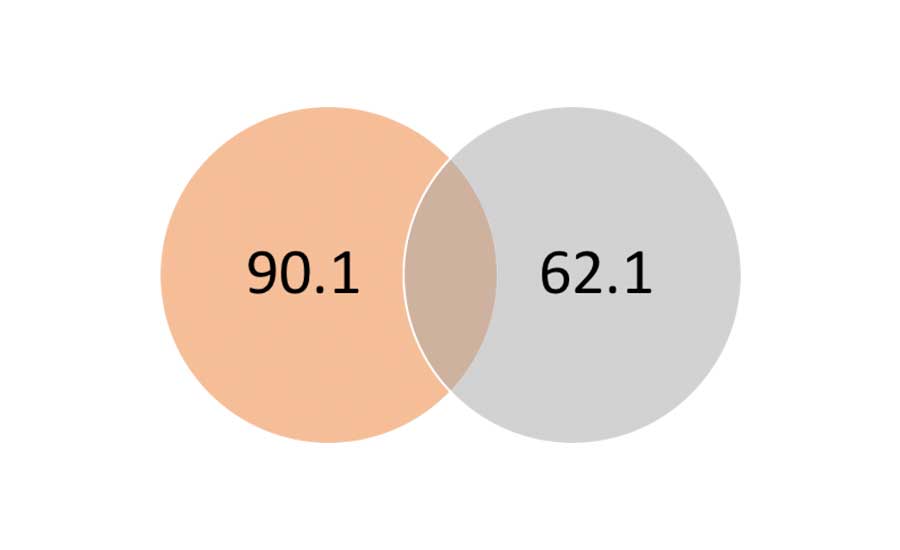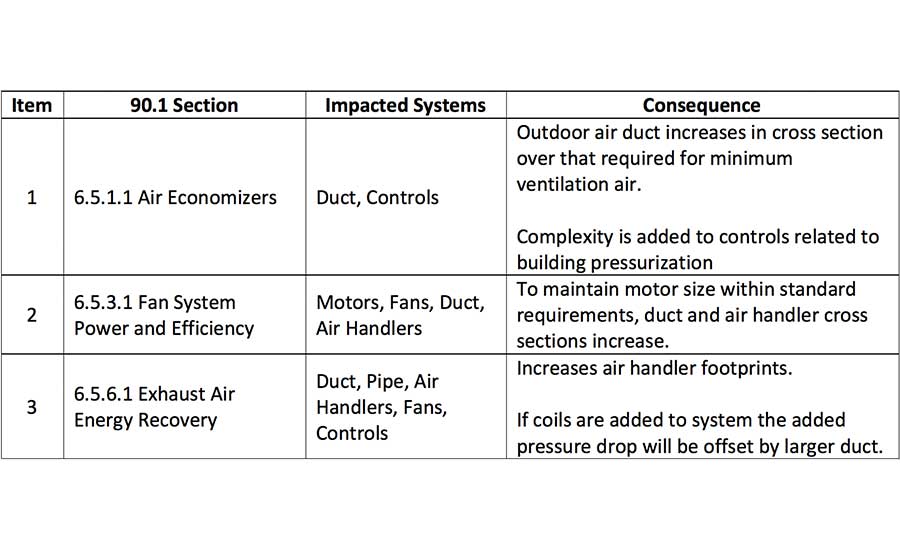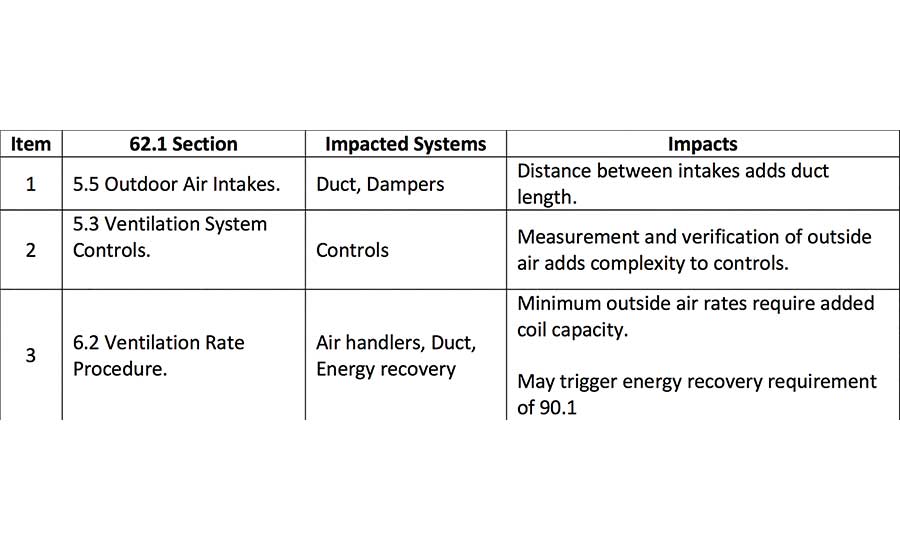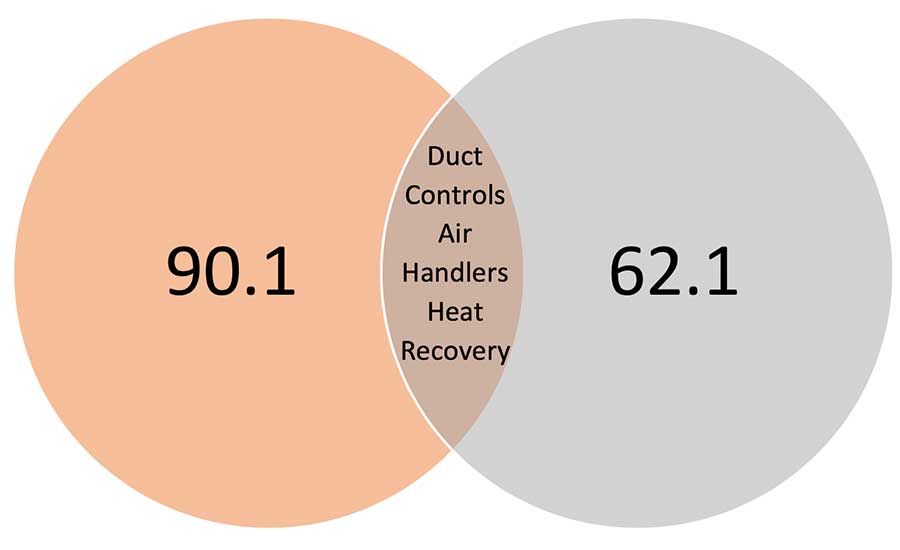Design often creates the sensation of being in a box with the sides moving in and no means of escape. I’m guessing I’m not alone in this experience. I recently felt this when a client’s highly constrained, existing architecture pushed the design toward an obvious but novel approach of ganging two large air handlers, one in a rooftop penthouse and the other in the basement directly below the penthouse, by common supply and return risers.
This idea was inspired when the physical constraints of the existing building along with the volume of outside air required to satisfy ASHRAE 62.1 triggered the energy recovery requirements of ASHRAE 90.1, which mandate an enthalpy recovery ratio of at least 50 percent. This last requirement pushed the design to an enthalpy wheel — the only means to achieve a 50 percent recovery in the client’s climate. As a result, the proposed system introduces the outside air through the penthouse unit with the basement unit, which is too constrained to be equipped with a wheel, becoming a recirculating unit. The outside air from the penthouse unit mixes with return and supply air from the basement unit in the risers. In this project, the side of the box representing ASHRAE 90.1 and the side representing ASHRAE 62.1 were pushing in as well as the sides representing the physical constraints of the building and the owner’s project requirements (OPR), which include the all-important budget constraints. How does an engineer navigate the web of codes (regulatory requirements), industry standards, physical constraints, and OPR? This article explores the balance between ASHRAE Standards 62.1 and 90.1 and possible solutions.
The Standards
ASHRAE Standard 62.1-2016 establishes indoor air quality requirements for buildings, except those within dwelling units in residential occupancies. Its purpose is to specify minimum ventilation rates and other measures intended to provide indoor air quality that is acceptable to human occupants as well as minimize adverse health effects. Although ASHRAE Standard 55-2013, which defines the thermal conditions required for comfort, is critical to indoor air quality, it does not prescribe design measures and, as such, won’t be referenced any further in this article.
ASHRAE Standard 90.1-2016 provides the minimum energy-efficiency requirements for the design and construction, and a plan for operation and maintenance of:
-
New buildings and their systems;
-
New portions of buildings and their systems;
-
New systems and equipment in existing buildings; and
-
New equipment or building systems specifically identified in the standard that are part of industrial or manufacturing processes.
Although standards 90.1 and 62.1 have been coordinated by their respective standards committees and don’t inherently conflict with each other, the realities of project constraints create challenges in crossing the tightrope where codes and project requirements buffet the design.
Providing indoor air quality creates pressures for meeting energy efficiency goals in the following ways:
-
Delivering outside air increases coil loads and, thus, the energy use intensity (EUI) of the building;
-
Filtering contaminants in outside air and return air increases pressure drop and, thus, increases the fan motor hp;
-
Capturing emissions generated in the space and exhausting them adds exhaust fans with pressure drop and, thus, motor hp; and
-
Separating exhaust discharge from operable windows and air intakes may increase duct lengths.
On the other hand, 90.1 requirements create the following challenges to the project:
-
Motor hp limitations increase AHU and duct footprints to reduce the system static pressure;
-
Economizer requirements add duct;
-
Demand-controlled ventilation requires additional controls points;
-
Energy recovery requirements increase air-handler footprints and add pipe and equipment to the project;
-
Controls costs escalate due to complexities added by energy efficiency measures; and
-
Complexity created by added controls compromises system stability.
The provisions in 62.1 and 90.1 define a “nexus.”
Mathematically, the intersection of the two sets in the Venn diagram in Figure 1 is represented as:

This can be defined as the nexus. The system selection must be within the intersection of these sets.
As noted previously, Standard 62.1 pushes design toward higher pressure drops in the air-handling system due to longer duct runs to maintain separation between intakes and exhaust and filtration requirements, while Standard 90.1 drives the design toward lower pressure drop. A sample of the design impacts from the two standards are summarized in Tables 1 and 2.
The Venn diagram in Figure 2 suggests that duct, pipe, controls, air handlers, and energy recovery form the nexus of the design.
Although many other system components are affected by these two standards, the focus of this paper is how design can manage those affected by both standards, such as duct layout, controls design and specification, the air-handler selection, and heat recovery design.
Duct Layout
Typically, the addition of outside air and separation between intakes and exhaust stipulated by Standard 62.1 add length to the duct layout, which challenges the motor horsepower limitations in 90.1 by adding pressure drop. Further, economizers required by Standard 90.1 require outside air and the relief air duct to be sized for 100 percent outside delivery. Mitigation strategies include the following:
-
Avoid discharging Class 2, 3, or 4 as defined by Standard 62.1 in the same plane as air intakes. This will typically provide the most direct route for duct. For example, in multifamily residential units, if the toilet exhaust is routed to the wall, you should provide outside air from a rooftop unit, such as a DOAS. The opposite will also be true.
-
If an air economizer is required by ASHRAE 90.1, locate air handlers on the roof or in a penthouse to allow for minimal duct runs. Locating an air handler requiring a full air-side economizer on floors with program space will significantly challenge the space program while providing little space for routing outside air and relief duct.
Controls
To comply with Standards 62.1 and 90.1, provide controls as stipulated in the standards. A sampling of these requirements are as follows:
1. Ventilation systems need the following:
a. Provide manual or automatic controls to maintain not less than the outdoor air intake flow required by Standard 62.1 for all load conditions or dynamic reset conditions (62.1 § 5.3.1).
b. Provide systems with fans supplying variable primary air, including single-zone VAV and multiple-zone recirculating VAV systems with one or more of the following (62.1 § 5.3.2):
i. Outdoor air intake, return air dampers, or a combination of the two that modulates to maintain not less than the outdoor air intake flow.
ii. Outdoor air injection fans that modulate to maintain not less than the outdoor air intake flow.
iii. Other means of ensuring compliance with the standard.
2. Economizers require the following:
a. Sequence dampers with the mechanical cooling equipment and do not control them only by mixed-air temperature (90.1 § 6.5.1.1.2).
b. Configure economizer controls to automatically reduce outdoor air intake to the design minimum outdoor air quantity when the outdoor air intake will no longer reduce cooling energy use (90.1 § 6.5.1.1.3).
c. Provide a means to relieve excess outdoor air during air economizer operation to prevent overpressurizing the building (90.1 § 6.5.1.1.5).
d. Outdoor air, return air, mixed air, and supply air sensors shall be calibrated within the following accuracies (90.1 § 6.5.1.1.6):
i. Dry-bulb and wet-bulb temperatures shall be accurate to ±2°F over the range of 40°-80°F.
ii. Enthalpy and the value of a differential enthalpy sensor shall be accurate to ±3 Btu/lb. over the range of 20-36 Btu/lb.
iii. Relative humidity shall be accurate to ±5 percent over the range of 20-80 percent rh.
Air Handlers
The pressure drop in air handlers contributes to the required motor horsepower, and heat recovery requirements in 90.1 add to the air handler footprint, sometimes beyond the physical constraints of the building. Some suggestions to facilitate compliance with the standards are:
-
Size air handlers to minimize pressure drop. This strategy includes maximizing the cross-section area of the unit and reducing the pressure drop associated with coils and filters.
-
Consider eliminating filters.
-
If energy recovery is required and the system has multiple air handlers, consider a DOAS to minimize the impact of energy recovery on the air-handling systems.
Heat Recovery
Standard 62.1 demands the introduction of outside air to the HVAC system. In turn, Standard 90.1 commands that exhaust air systems be equipped with energy recovery for systems exceeding a total design airflow and percentage of outside air at design flow for various climates. The systems requiring heat recovery expands with each new edition of 90.1. As a result, good design practice necessitates a rigorous basis. Some suggestions are as follows:
1. Be certain of the energy code enforced by the authority having jurisdiction (AHJ). Significant differences exist between versions of the same code and the various codes enforced by the AHJ.
2. Have an impeccable understanding of the code language. If the design is proceeding without energy recovery because of the use of an exemption, make certain that the client and AHJ are in agreement with your interpretation.
3. Recognize the limitation of heat recovery systems with respect to the code requirements. Section 6.5.6.1 of Standard 90.1 states:
“Energy recovery systems required by this section shall result in an enthalpy recovery ratio of at least 50%. A 50% enthalpy recovery ratio shall mean a change in the enthalpy of the outdoor air supply equal to 50% of the difference between the outdoor air and entering exhaust air enthalpies at design conditions.”
In many climates, this will require a total enthalpy device. In fact, an early interpretation of this section from ASHRAE recognized this possibility:
“The standard’s energy recovery performance requirement may be met using any energy recovery technology; it is not limited to enthalpy wheels that directly achieve both sensible and latent heat recovery. Using a winter heat recovery example, if a sensible-only energy recovery technology is applied, its sensible effectiveness must be sufficient to achieve a dry-bulb temperature rise in the outside air as it passes through the recovery device so that the supply air leaving the device has achieved an enthalpy rise of at least 50% of the outside air, return air enthalpy difference. In practice, this means that if a sensible-only recovery technology is used, its sensible efficiency may have to be greater than 50% in order to achieve the required 50% total (or enthalpic) energy recovery effectiveness.
However, for summer outside air cooling, sensible energy recovery devices may only meet the 50% total energy recovery requirement in cool, dry summer climates. In most warm and hot climates, both dry and humid, a total energy, enthalpy recovery device will be required to meet the performance requirement of the standard.”
4. Be aware very early in the design process of the program space that’s required for the heat recovery equipment and be generous in your estimates of the space requirements.
With new technologies and design tools constantly emerging, the process of designing HVAC systems continues to grow in complexity. This is not helped by the strengthening of energy and indoor air quality requirements demanded by building codes. As walls of the project press closer, the best means of escaping their crush is a thorough design basis, which includes a comprehensive understanding of the code language and a liberal approach to its application.
Bibliography
ASHRAE 2013. ANSI/ASHRAE Standard 55-2016, Thermal Environmental Conditions for Human Occupancy, Atlanta: American Society of Heating, Refrigerating, and Air Conditioning Engineers Inc.
ASHRAE 2016. ANSI/ASHRAE, IESNA Standard 90.1-2016, Energy Standard for Buildings Except Low-Rise Residential Buildings (I-P Edition). Atlanta: American Society of Heating, Refrigerating, and Air Conditioning Engineers, Inc.
ASHRAE 2016, ANSI/ASHRAE Standard 62.1-2016, Ventilation for Acceptable Indoor Air Quality, Atlanta: American Society of Heating, Refrigerating, and Air Conditioning Engineers Inc.
INTERPRETATION IC 90.1-2001-7 OF ANSI/ASHRAE/IESNA STANDARD 90.1-2001 Energy Standard for Buildings Except Low-Rise Residential Buildings, June 23, 2002.









